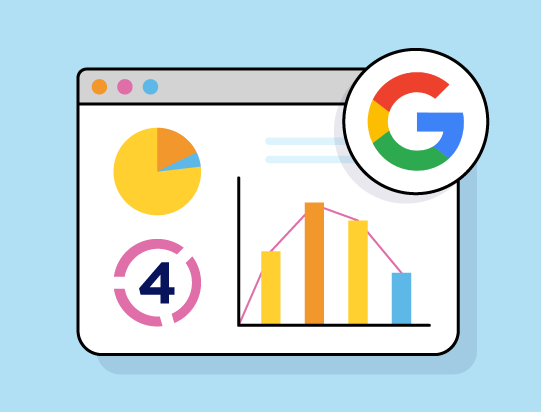There’s a new update released for Google Analytics (GA) called Google Analytics 4 (GA4). This update raises many marketers’ curiosity, as the impact can be significant in terms of what data/information will be visible and how they can keep track of conversion and performance. This could change how we analyze data and make informed decision-making.
Development of Analytics 4
Google Analytics 4 (GA4) has been under development since Firebase Analytics was released in 2017 and is actually built based on the Firebase Analytics’s backend. It has been under work for years, and the beta version was released in July 2019 but was called “App + Web Properties” instead of GA4. As the beta name reflects, GA4 is made to streamline the tracking between mobile and web.
The current Google Analytics we’re using is called the “Universal Analytics”. We have a timeline illustration below, and it shows that the current GA we’re using has been around for seven years, and in this fast-paced digital world – that’s a long time. We’ve certainly gotten familiar and used to the current GA, so it’s time to flex some muscles to learn about the new GA4.
- GA1: Urchin, 2005.
- GA2: Classic, 2008.
- GA3: Universal, 2013.
- GA4: The newest update in 2020.
Main Difference of Universal Analytics With GA4
The most significant shift brought by the GA4 is the focus on the event-driven data model. The current GA relies on page views and custom events, while in the new model, all you track are events.
GA4 is still under continuous development, so there are still features coming up, and it’s still not fully ready to replace the universal analytics that we’re using currently. However, considering that GA4 will be the future, it’s good to explore it and get ourselves familiar with it, so when it’s fully ready, we can shift with less friction.
One of the exciting things about GA4 is that they bring in some features previously only available to GA360 users (A paid enterprise version of Google Analytics). Other than those features, the UI is also changing, bringing changes into metrics available. It is expected to redefine how we read, understand, and analyze the data to gain insights.
The 3 significant differences between GA and GA4 are:
- Advanced event tracking
- Merged analytics for Web and Mobile
- Enhanced time-based metric
1. Advanced event tracking
By default, GA simply tracks the page views that go in your property, and you’ll have to set up a custom event for other interactions. To do that, you’ll have to know more about event tracking and Google Tag Manager. Meanwhile, GA4 tracks more data and information by default, and there are “enhanced measurement” that could automatically track scrolling data, outbound clicks, downloading files, and others.
Should there still be other data that you’d like to track, you can access Event Setting and add it according to your needs.
Events in GA4 is divided into four categories:
- Automatically collected events: Events that GA4 automatically tracks
- Enhanced Measurement events: Optional events you can enable to track with Enhanced Measurement Events
- Recommended events: Recommended Events to track but require context for the data to be meaningful.
- Custom events: Define an event that’s outside of what’s already available in GA4
You can refer to the usage in the flowchart below.
In the current GA (Universal Analytics) version, events are user interaction measured independently from web pages/page load. Other interactions, such as download, clicks, form fills, etc., are tracked as custom events. These events have category, action, label, and we could also attach value to them, which can be included and displayed in the analytics report.
In GA4, events are defined as user interaction with an app/website that can be measured concurrently or independently from page load. Event examples in GA4 would be page views, button clicks, user interaction, and system events. To illustrate better, here’s a table below how things in GA are turned into events by definition in GA4.
2. Merged analytics for Web and Mobile
We mentioned earlier that GA4 is combining mobile and web data such that marketers don’t have to use 2 different tools (E.g. Google Analytics and Firebase) separately. Even if both Google Analytics and Firebase are Google properties, the communication between these two platforms isn’t perfect, and there are still discrepancies and challenges in making meaningful data. By merging, this also allows a better and smoother tracking data integration.
As GA4 is based on Firebase, Firebase users can pull and import historical data. The same can’t be said for importing historical data from GA to GA4, which is caused due to differences in how they’re built. Therefore it’ll be a good idea to add the global tag to GA4 now and start gathering the data even if you don’t need or intend to use it for now.
3. Enhanced time-based metric
With GA4, we will be able to exclude certain users from an audience based on their actions or conditions. This exclusion can also be temporary or permanent in nature. Why is this interesting? Because it’ll play a significant role in retargeting/remarketing campaigns.
For example, someone just bought our products. Because they’ve recently converted, it’s unlikely for them to buy again immediately. But we also don’t want to not target them forever. So with this feature, we’ll be able to exclude this audience temporarily until they’re ready to be remarketed again as a repeat purchaser.
The new time metric is also more informative. The current time metric measures time spent on a page, a session, or per user. It’s hard to know how much time it takes for a user to convert (e.g. fill in a form). But with GA4, there’s an “elapsed time” feature where we can see on average how much time a user spent in a property before taking a specific action (e.g. how long they spent before they download, watch video, add to cart, or fill in a lead form).
What Else is New in Google Analytics 4?
There are a few other unique updates in GA4:
- New Debug mode
- Funnel builder
- Simpler Export to BigQuery
New & Improved Debug Mode
The current debugging with GA is complicated. You’d have to investigate one by one, for example, does the problem lie in GTM? Or is it in one of the web properties? However, with GA4, you can say goodbye to that with a live debugging view. Debug can be done directly on the interface, or if you’re using the GTM Chrome extension, you’ll be able to see the data imported in real-time to figure out where the issue lies.
With Debug View, we’ll be able to isolate events, parameters, and user properties that cause some bugs. While the debug view is active, data will be filtered out from your standard reporting such that the data from testing doesn’t get mixed in with actual user data. Furthermore, the test data will also be sent immediately in debug mode; Without debug mode, GA4 will group events in one before sending the data in stages.
UI Changes
UI or User Interface in GA4 will change and certainly require some getting used to, especially to those already accustomed to the current GA version. Don’t get too comfortable with sticking to GA as eventually this version will be phased out and support will be pulled, albeit it may take a few years to happen. GA4 will continually be improved and updated, so stay tuned to improvements and when it’s finally ready as standalone.
We’ve provided a few screenshots as UI preview in GA4
Overview
Events
All Events
Change in Funnels & Funnel Builder
With GA4, we’re now able to access the funnel feature previously only available to those who use GA360. This funnel feature will be able to be customized and works retroactively. We’ll also be able to segment the funnel for analysis.
Funnel View
Segmenting View
There are also templates for funnels that you can use, especially for commonly used ones, so you won’t have to start from scratch. Take a look, and you may want to explore that with your GA4.
Export to BigQuery
For BigQuery users, now you’ll be able to export data directly from GA4 to BigQuery. This integration makes it easier for you, and also, you’ll be able to obtain raw event data that goes into your data warehouse. This will enable the data scientists to create predictive analytics, machine learning models, and other customization with varied and wide possibilities. There’s also an option on where you would like to host/keep your data to comply with data governance rules.
This export feature will be even faster than what’s currently available for GA360, cutting down integration time from 15 minutes on average into a matter of seconds. You can also use this feature on BigQuery Sandbox, which is the free version of BigQuery.
Do you shift to GA4 now?
GA4 is still relatively new and isn’t quite fully equipped as a stand-alone. There are bugs to be sorted and features to be implemented. Listed below are some features still under development on GA4:
- Basic Reporting Feature is still challenging to use
- Incomplete Attribution/multi-channel funnel
- Integration features incomplete
- Still under heavy development (There may be bug/changes)
- Limited integration with data studio for now
- Few filters yet to be available.
- E-commerce features incomplete
Other than the technical side that still needs to be developed, for marketers, we will need to re-learn and re-familiarize ourselves with the new GA4. Because the foundation that the GA4 is built on is different from GA, there are plenty of the available default reports in GA that will be removed or changed. These changes likely bring new ways of doing things and change in how we read or use data. The popular metric such as “medium” and “bounces” will be removed, and thus we will have to find a different way to measure. For GA360 users, there’s also little information on the GA4 version of 360, so stay tuned.
In conclusion, it’s advisable to start implementing GA4 for the sake of data collection and also to familiarize ourselves with it. However, for analysis and reporting purposes, we can stick with GA for now. It’s good to keep in mind that GA4 will replace the current GA, although it may take a while, so there’s no harm in taking steps now to learn about it and gather historical data to use in the future.
We hope this article is informative and can be the basis for you to explore further regarding GA4. Kaliber blog hosts many other interesting articles that can be useful for you. Just click here to find more articles like this.




























